2.2Phonetics
语言学chapter 2 phonetics

To make a speech sound visible so that we can measure its components objectively we must then go into the domain of acoustic phonetics, which studies the physical properties of speech sounds, as transmitted between mouth and ear.
3.1.2 Places of articulation
In terms of place of articulation, the English consonants can be classified into the following types:
bilabial
labiodental
j
4. Vowels (refer to Poole, 2000: 60)
4.1 cardinal vowels 基本元音(refer to Poole, 2000: 50-51)
British phonetician Daniel Jones first fixed the qualities of the two vowels which were produced with the tongue is as high and as far forward as possible in [i]. Another, represented by [a], is the sound produced when the tongue is as low as possible at the back. The other six vowels have been plotted down between these two extremes, the front vowels being plotted at equal acoustic distances as are the back vowels.
2 Phonetics 语音学
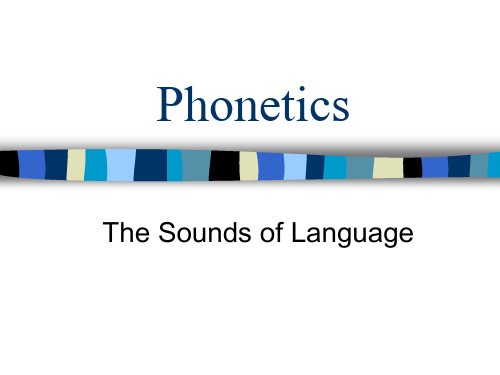
The speech organs of the human being consists of three major areas: the pharyngeal cavity (the throat), the oral cavity (the mouth), and the nasal cavity (the nose) The air stream coming from the lungs may be modified in these cavities in various ways. Such modification results from some kind of interference with the movement of the air stream. Of these speech organs the very flexible tongue is of particular importance, because the principal source of sound modification is the tongue. So much so that the word for it is often used as a synonym for language: English mother tongue, French langue, Russian ЯЗЬІΚ, and so on (Poole 1999: 42)
5. Transcription of speech sounds
Transcription; the use of symbols to show sounds or sound sequences in written form. There are different systems of phonetic symbols. One of the most commonly used is that of the International Phonetic Association.
英语语言学 第二章 Phonetics and Phonology
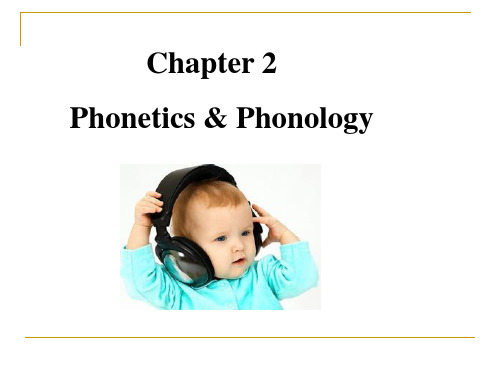
scope of phonetics
articulatory phonetics
auditory phonetics
acoustic phonetics
articulatory phonetics 发音语音学 From the speaker’s point of view: studying how a speaker uses his or her speech organ to articulate sounds ( 研究语音的产生)
当声带分离时,气流容易通过,由此产生的语 音叫清音(voiceless),如 [p, s, t]。 当声带贴近时,气流使其产生震动 (vibration),形成的声音成为浊音 (voicing),如[ b, z, d]。 当声带完全紧贴时,气流无法通过,不发出声 音。
pharyngeal cavity: Vibration of the vocal cords results in a quality of speech sounds called voicing, which is a feature of all vowels and some consonants in English.
2.1 the phonic medium of language
two media of language : speech and writing Sounds which are meaningful in human communication constitute the phonic medium of language.
2.2.2 speech
organs (发音器官)
2.2 Phonology
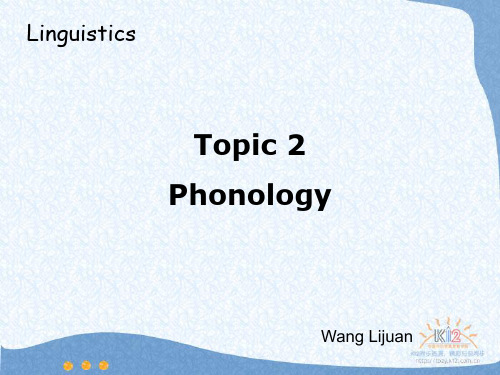
allophones of the phoneme /p/
2.2.2 Phonemic contrast, complementary distribution and minimal pair.
Phonemic contrast (音位对立 音位对立) 音位对立
• Phonemic contrast----if two or more sounds can occur in the same environment and the substitution of one sound for another brings about a change of meaning, they are said to be in phonemic contrast (or contrastive distribution). • Different or distinctive phonemes are in phonemic contrast, e.g. /b/ and /p/ in [ bit ] and [pit].
1. /k/
2. /g/ 3. /p/ 4. /l/ 5. /e/ 6. /m/ 7. /t/
8. /n/
1. [k] [kȹ] [c] [cȹ] [k¬] [c¬] 2. [ ] [g] 3. [p] [pȹ] [p¬] 4. [l] [ɫ] ɫ 5. [e] [ ] 6. [m] [ɱ] 7. [t] [tȹ] [t¬] [ ] 8. [n] [ ]
2.2.1 Phone, phoneme, allophone
Question: Do the underlined letters or letter combinations in each group share the same pronunciation?
2.1&2.2Phonetics
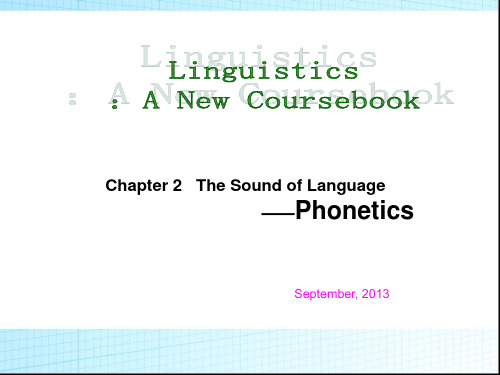
Voiced and voiceless sounds
• Two physical ways to distinguish voiceless and voiced sounds: • 1)Put a finger in each ear and produce sounds like "z-z-z-z-z" and "s-s-s-s-s" separately. • 2)Rest your fingers on the top of your "Adam's apple" and produce sounds like "z-z-z-z-z" and "s-s-s-s-s" separately.
Articulatory phonetics, which is the study of how speech sounds are produced, or “articulated”. Acoustic phonetics, which deals with the transmission of speech sounds through the air. Auditory phonetics, which deals with how speech sounds are perceived by the listener.
Organs of Speech: Mouth&Nose
• The pharynx, mouth, and nose form the three cavities of the Vocal Tract, namely the Pharyngeal cavity, the Oral cavity and the Nasal cavity.
《语言学教程》Chapter 2 phonetics

Main contents in Chapter 2
Phonetics Speech sounds Sounds Phonology Sound systems 1. Phoneme, phone, allophone ClickPhonological 2. to add Title processes
2.2 Consonants and vowels
Preview questions: 1. What are consonants and vowels? 2. What is the major difference between consonants and vowels? 3. In what ways can we describe consonants and vowels respectively?
Chapter Two Speech Sounds
What is Phonetics?
Phonetics (语音学) studies how speech sounds are produced, transmitted, and perceived. It is concerned with all the sounds that occur in the world’s languages.
Performance
Performance is often influenced by psychological and social factors; it is not stable.
A speaker’s performance does not always match or equal his supposed competence. Chomsky believes that linguists ought to study competence, rather than performance. In other words, they should discover what an ideal speaker knows of his native language.
戴炜栋语言学-Chapter 2 Phonology
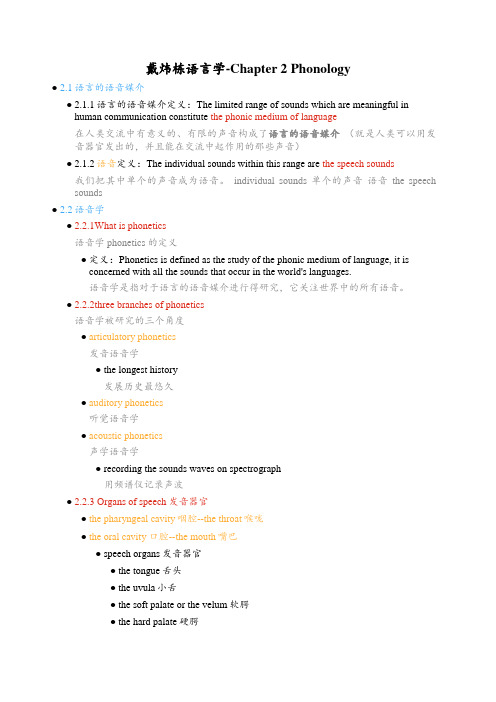
戴炜栋语言学-Chapter 2 Phonology●2.1语言的语音媒介●2.1.1语言的语音媒介定义:The limited range of sounds which are meaningful inhuman communication constitute the phonic medium of language在人类交流中有意义的、有限的声音构成了语言的语音媒介(就是人类可以用发音器官发出的,并且能在交流中起作用的那些声音)●2.1.2语音定义:The individual sounds within this range are the speech sounds我们把其中单个的声音成为语音。
individual sounds 单个的声音语音the speech sounds●2.2语音学●2.2.1What is phonetics语音学phonetics 的定义●定义:Phonetics is defined as the study of the phonic medium of language, it isconcerned with all the sounds that occur in the world's languages.语音学是指对于语言的语音媒介进行得研究,它关注世界中的所有语音。
●2.2.2three branches of phonetics语音学被研究的三个角度●articulatory phonetics发音语音学●the longest history发展历史最悠久●auditory phonetics听觉语音学●acoustic phonetics声学语音学●recording the sounds waves on spectrograph用频谱仪记录声波●2.2.3 Organs of speech发音器官●the pharyngeal cavity咽腔--the throat喉咙●the oral cavity 口腔--the mouth嘴巴●speech organs发音器官●the tongue舌头●the uvula小舌●the soft palate or the velum软腭●the hard palate硬腭●the teeth ridge齿龈●the teeth齿●the lips唇●如何发音●舌和软腭阻塞-[k],[g]●硬腭和舌前之间的空间变窄--[j]●舌尖和齿龈之间的阻塞--[t][d]●前齿上部和舌尖部分阻塞--[θ][ð]●上唇和下唇阻塞--[f][v]●双唇之间阻塞--[m][n][ŋ]●the nasal cavity 鼻腔--the nose鼻子●鼻音化:鼻腔张开,让气流全部或部分通过,例如三个鼻辅音[m][n][ŋ]●通过声带震动产生的2个语音特征●voicing浊化●voiceless清音●2.2.4 Orthographic representation of speech sounds--broad and narrow transcriptions语言的正字法表征--宽式标音和严式标音●broad transcription宽式标音●国际音标International Phonetic Alphabet, 挑选出一个字母,用来代表一个语音●用代表字母的符号来标音the transcriptions with letter-symbols only transcription标音●narrow transcription严式标音●定义●“严式音标”用来记录“音素”,音标写在方括号 [ ] 之间。
简明语言学第二章笔记

4) by the length of the vowels Tense vowels: long vowels Lax vowels: short vowels
2.3 Phonology
2.3.1 Phonology and phonetics 2.3.2 Phone, phoneme, and allophone 2.3.3 Phonemic contrast, complementary distribution, and minimal pair 2.3.4 Some rules in phonology 2.3.5 Suprasegmental features — stress, tone, intonation
[ph]
[l] clear /l/
[l] dark
2.3.3 Phonemic contrast, complementary distribution, and minimal pair
1) Phonemic contrast(音位对立): if two phonetically similar sounds are two distinctive phonemes, they are said to form a phonemic contrast. eg. /p/ and /b/ in [pit] and [bit]
Chapter 2 Phonology
2.1 The phonetic medium of language 2.2 Phonetics 2.3 Phonology
2.1 The phonic medium of language
The limited range of sounds which are meaningful in human communication constitute the phonic medium of language; and the individual sounds within this range are the speech sounds.
- 1、下载文档前请自行甄别文档内容的完整性,平台不提供额外的编辑、内容补充、找答案等附加服务。
- 2、"仅部分预览"的文档,不可在线预览部分如存在完整性等问题,可反馈申请退款(可完整预览的文档不适用该条件!)。
- 3、如文档侵犯您的权益,请联系客服反馈,我们会尽快为您处理(人工客服工作时间:9:00-18:30)。
辅音+元音型
An apple In April His eyes At Easter Some oil Keep on
• [u:] : back, rounded, close, long vowel
• (Liu's version)
• • •
high, back, tense/long, rounded vowel (Hu's version) [ɔ]: back, rounded, open and short
•
low, back, lax/short, rounded vowel
Monophongs and diphthongs
• Diphthongs are also called gliding vowels, as in contrast to pure vowel or monophthongs. Theay are produced by moving form one vowel position to another through intervening positions. • There are 8 diphthongs in English: • [ei] [ai] [ɔi] [əu] [au] [iə] [εə] [uə]
Liaison
What is liaison?
Such a phenomenon of the linking of words in speech, in particular when the second word begins with a vowel, is called liaison.
(1)the height of the tongue raising (high, mid, low)
• High: [i:] [i] [u:] [u] ——Close • Mid: • Low: [æ ] [a] [ɔ] [a:]——Open
(2)the position of the highest part of the tongue (front, central, back)
(1)the height of the tongue raising (high, mid, low)
• Alternatively, tongue height can be described ad Close, Close-Mid, Open-Mid, and Open, in reference to the way the two lips are rounded when producing sounds with different tongue height. • the inverse relationship between tongue height and openness of the mouth
• her: /həː/→/hə, əː, ə/
• him: /him/→/im/ • his: /hiz/→/iz/ • I: /ai/→/aː, ə/ • is: /iz/→/s, z/
• many: /'meni/→/mni/ • me: /miː/→/mi/ • must: /mʌst/→/məst, məs/ • my: /mai/→/mi/ • of: /əv/→/əv, v, ə/
• • • • •
小结
• 一般来说: 实词重读,如动词、名词、副词等; 虚词弱读,如介词、代词等 • 弱读的规则一般是:元音音节弱化成 [ə] 比如说如下几个单词:for/to/some/does/of
Types of liaison来自 (4 types)• (1) To blend or join the final consonant of one word with the initial vowel of the following words, as in "post office".
• the symbol ":" and its absence are used for the lenght of the vowels. • Long vowels: [i:] [ə:] [u:] [ɔ:] [a:]
(4)lip-rounding
• • • • • Rounded vowels: Back vowels: [u:] [u] [ʌ] [ɔ:] [a:] [ɔ] Unrounded vowels: Front vowels: [i:] [i] [e] [ε] [æ ] [a] Central vowels: [ə:] [ə]
• low, back, lax/short, rounded vowel
Exercise
1 Vowel description:
• [i:] [i] [e] [ε] [æ ] [a] • [ə:] [ə] [ʌ] • [u:] [u] [ɔ:] [a:] [ɔ] 2 Draw the diagram that indicates the positions of vowels in the oral cavity.
Strong forms and weak forms强读与弱读
Strong forms and weak forms 强读与弱读
• 大多助动词、系动词、介词、连词、冠词、代词,都有两 种发音形式:强读式、弱读式。 • 这些单词往往都是单音节单词。以下是其中最常见最普及 的强读式、弱读式对照列表。
Lecture 4 Chapter 2 The Sound of Language
——Phonetics(2)
September, 2013
2.2 Phonetics
• 2.2.4 Classification of English speech sounds: English consonants and Vowels • 2.2.5 Variations of sounds: • Liaison & Elision & Assimilation
English vowels
Front Central Back
High (close)
i: i e mid-high εmid-low æ a ə ə:
u: u ʌ ɔ: a: ɔ
Mid (semi-close semi-open) Low (open)
Vowel description (two Versions)
• Front vowels: [i:] [i] [e] [ε] [æ ] [a] • Central vowels: [ə:] [ə] [ʌ] • Back vowels: [u:] [u] [ɔ:] [a:] [ɔ]
(3)the length or tenseness of the vowel
• do: /duː/→/du, də, d/ • does: /dʌz/→/dəz, z, s/ • for: /fɔː/→/fə/ • from: /frɔm/→/frəm, frm/ • had: /hæ d/→/həd, əd, d/ • has: /hæ z/→/həz, əz, z, s/ • have: /hæ v/→/həv, əv, v/ • he: /hiː/→/hi, iː, i/
Exercise
• 1 Vowel description: • [u:]: back, rounded, close, long vowel
• (Liu's version)
• high, back, tense/long, rounded vowel • (Hu's version) • [ɔ]: back, rounded, open and short
• our: /ɑʊɚ/→/ar/
• shall: /ʃæ l/→/ʃəl, ʃl/ • she: /ʃiː/→/ʃi/ • should: /ʃud/→/ʃəd, ʃd, ʃt/ • so: /səʊ/→/sə/
• some: /sʌm/→/səm, sm/
• such: /sʌʧ/→/səʧ/ • than: /ðæ n/→/ðən, ðn/
• that: /ðæt/→/ðət/ • the: /ði:/→/ði, ðə/ • them: /ðem/→/ðəm, ðm, əm, m/ • then: /ðen/→/ðən/
• to: /tuː/→/tu, tə/
• us: /us/→/əs/ • was: /wɔ/→/wəz, wə/ • we: /wiː/→/wi/ • were: /wəː/→/wə/ • when: /wen/→/wən/ • will: /wil/→/əl, l/ • would: /wud/→/wəd, əd, d/
• 注意,以下的列表不能当作规则使用,不是所有 的虚词在任何情况下都必须弱读;也不是所有的 实词都必须被强读。下面的列表只是在描述现象。
• • • • • • • • • • •
a: /eɪ/→/ə/ am: /æ m/→/əm, m/ an: /æ n/→/ən, n/ and: /æ nd/→/ənd, nd, ən, n/ any: /'eni/→/ni/ are: /a:/→/ə/ as: /æ s/→/əz/ at: /æ t/→/ət/ but: /bʌt/→/bət/ can: /kæ n/→/kən, kn, kŋ/ could: /kud/→/kəd, kd
Classification of vowels
• Monophthongs (pure vowels) and diphthongs (vowel glides) • Tongue rising: open (low), half-open (midlow), half-close (mid-high), close • Raised part: front, central, back • Tenseness (length): tense (long), lax (short) • Lip rounding: rounded, unrounded
